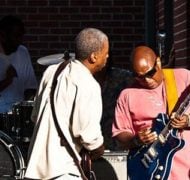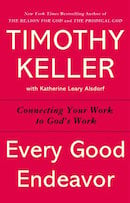Rethinking Scarcity: The Emergence of Creative Communities
Blog / Produced by The High Calling
I expect no one would disagree that creative innovation often arises from scarcity. From Ritz cracker apple pie to the dinners we developed with nothing but a microwave and hot pot during college, some creative spark in human nature thrives when put to the challenge of limited resources.
Likewise, in comparison to the booming creative industries of the 1990s, today’s musicians and authors—even some of those signed with major labels and publishers—are creating within the context of limited resources. While the leaders of the companies that produce and distribute much of our art are cautious about taking costly risks like launching a new artist, rapid developments in technology allow artists willing to take the risk themselves to bypass the industry and get their work into the hands of the audience. Adam Young of Owl City wrote in 2012: “Here at the outset of a new century everyone is back at the starting line fighting to be heard. It’s effortless to hear and steal new music so bands have to think of ways to reinvent themselves and turn the box inside out.”
So perhaps it is no surprise that there is a particular richness in some of the art being created today when economics and technology have joined together to topple the industries of yester-year.
When Economics and Technology Meet
In some cases, it is simply the ability to work outside of industry oversight that allows for rich creativity. Michael Gungor, in The Crowd, the Critic, and the Muse, writes, “Art as industry prods artists to think in terms of marketing channels rather than more substantive building blocks of art like beauty, emotion, protest, or honesty.”
Other times, though, the creativity comes from something much deeper and more essential to art which the downfall of the traditional systems—with their inherent feting of celebrity—has allowed to burgeon: creative community.
In order to successfully produce and distribute work, independent artists must build their own personal connections with others working in their fields. The musician must find a lyricist or a producer; the author must find an illustrator or an editor. Yes, those connections can be simply transactional business relationships, but more often than not, they tend to be—or to grow into—friendships. Iron sharpens iron, Scripture reminds us, and in community, creation becomes a living, shaping, honing process.
A Return to the Old Way
It’s a return to historical ways of doing art. The artists of Old Europe created art in ateliers, under the tutelage of masters. Oral storytelling, passed from generation to generation, predates written fiction. The folk music of many countries developed in community—whether it was slaves singing in the cotton fields or shepherds out with their flocks. Together the men of African tribes developed their hunting songs, and sailors, their sea shanties. Cowboys and drovers pulled out their guitars and harmonicas and sang songs together. These were songs of simple joys, of deep laments, of hard work, of everyday experience.
The same is true of independent musicians today who often sing those same sorts of songs. One group of artists that exemplifies this concept is the Square Peg Alliance—a group of musicians that joined forces a few years ago for support and collaboration. The group has changed over the years—some of the artists have signed to labels, others have moved on to new jobs, and new communities of those in other artistic fields have formed. But one thing remains the same with artists like Jill Phillips, Andy Gullahorn, Andrew Peterson, Eric Peters, and others in the Square Peg Alliance and among their friends: their music holds resonant honesty and depth.
The limitations the economy and technology have enforced upon the music industry may be the best thing that could have happened because, in part, the independent artists’ appeal lies in the fact that the stories their songs tell are real stories—of struggles, of joy, of pain, of glory.
That is a richness that the industry would never risk trying to market.
______________________________
Rethinking Scarcity
We all know the pinch of limited resources. Whether it's a crunch for time, a shrinking bank account, or a competitive workplace, we often experience life dissatisfied and craving more. At The High Calling, we are Rethinking Scarcity, attempting to understand how both real and perceived scarcity influences our thoughts and behaviors. We also will explore scarcity’s influence in our decisions and how reimagining constraints not only changes the way we respond to our circumstances, but ultimately may change our circumstances themselves. Join us for the conversation, and while you're at it, why not share some of these same resources via email or social media with friends or colleagues who also might also be interested.
Image by Andy Price. Used with permission. Sourced via Flickr.





